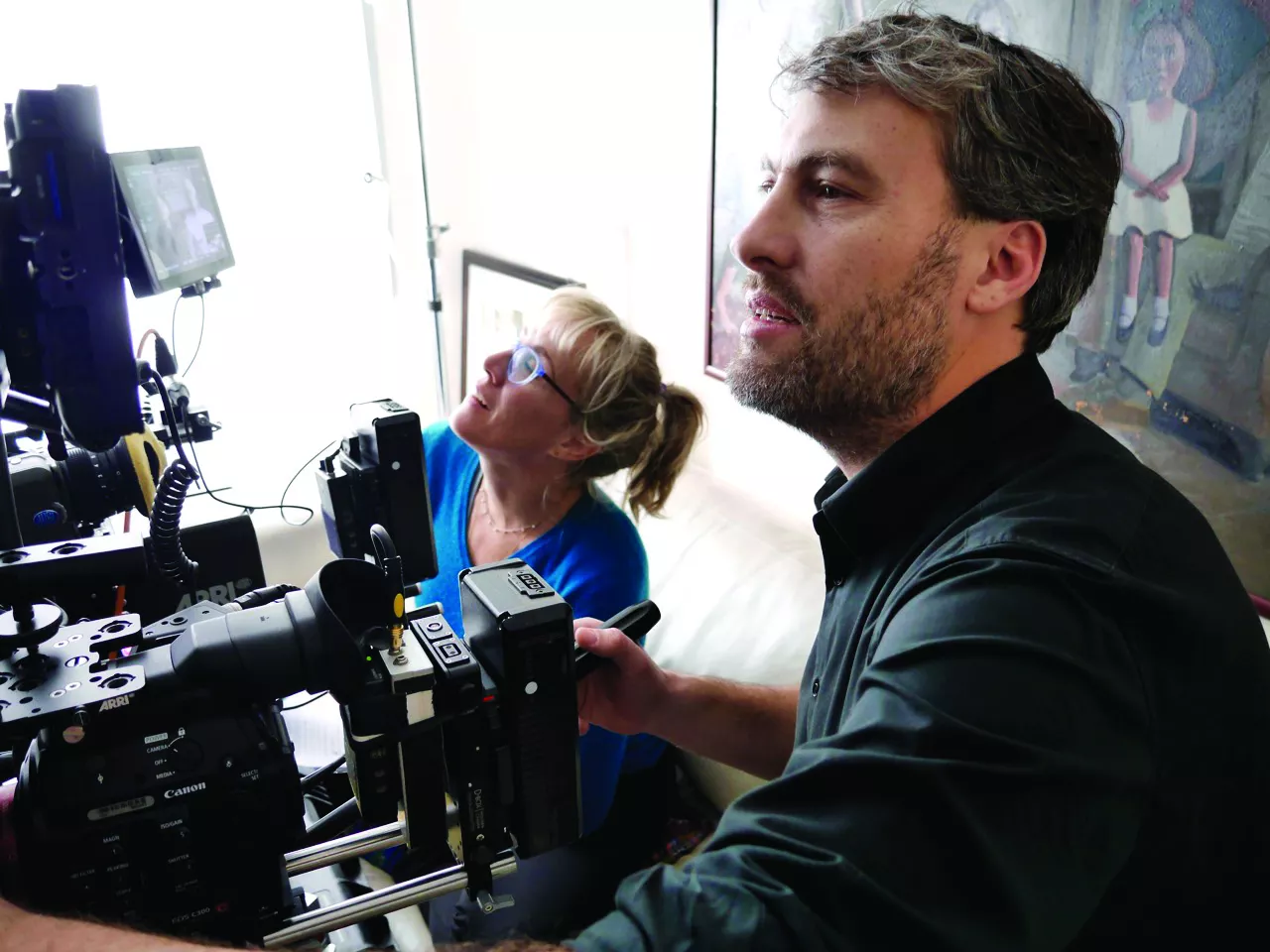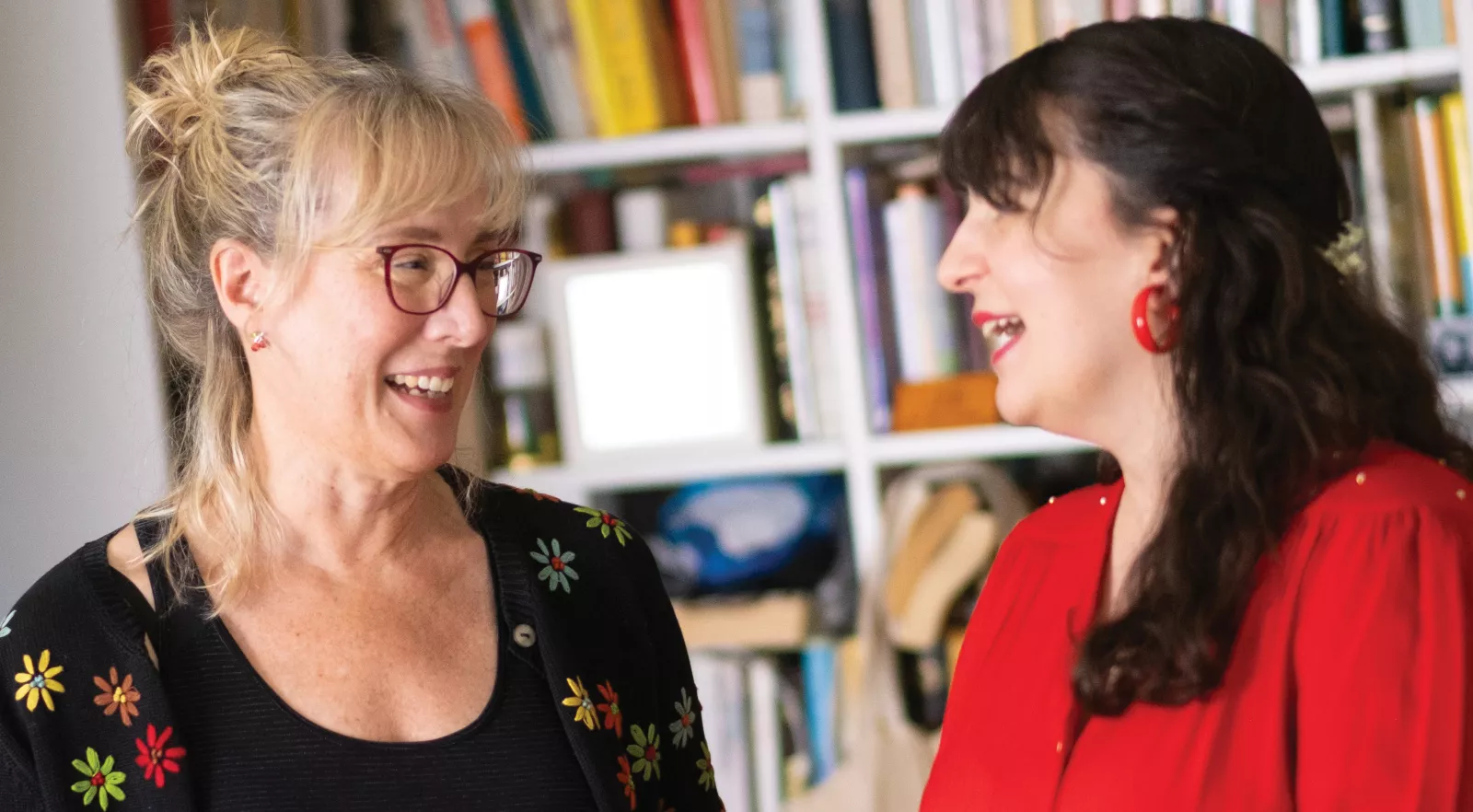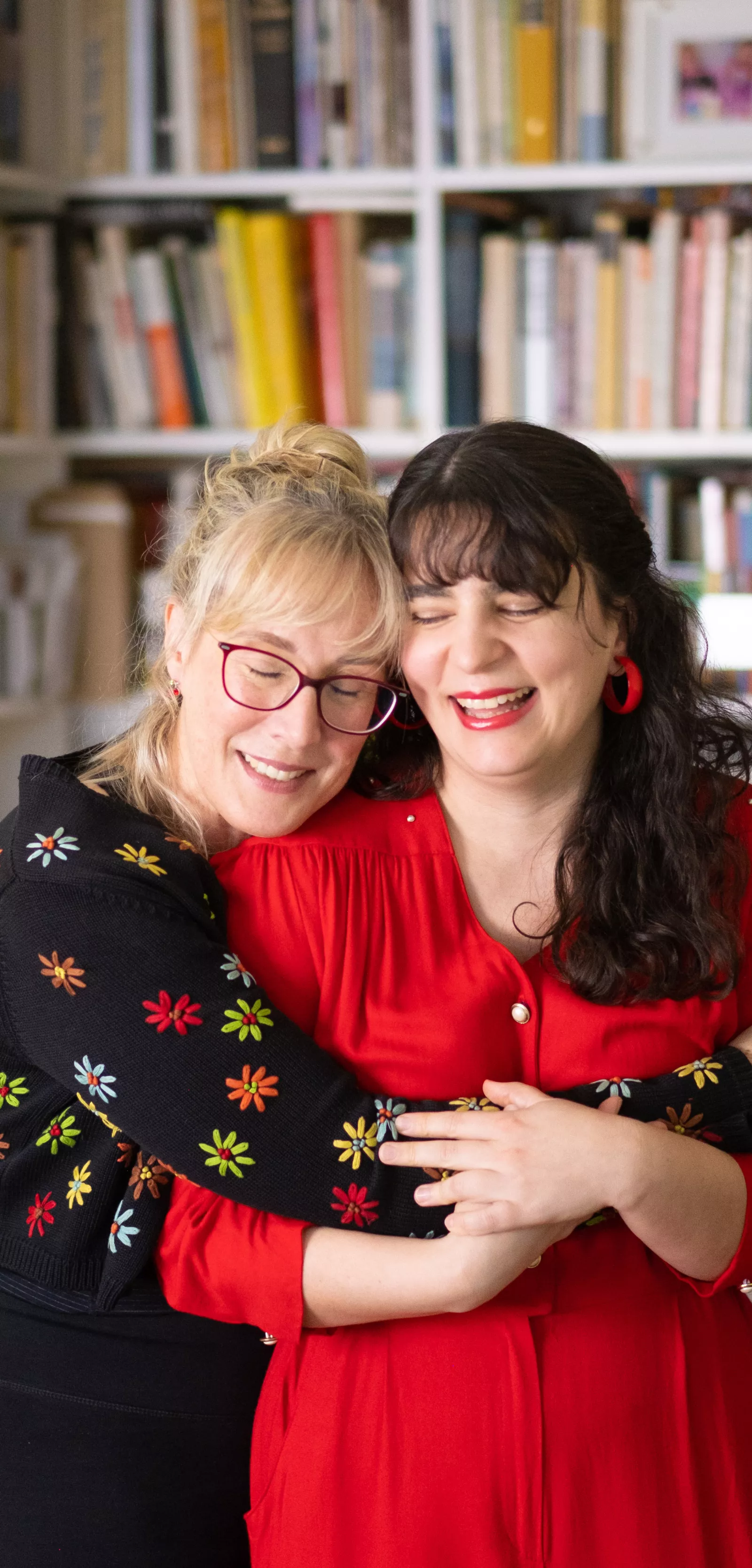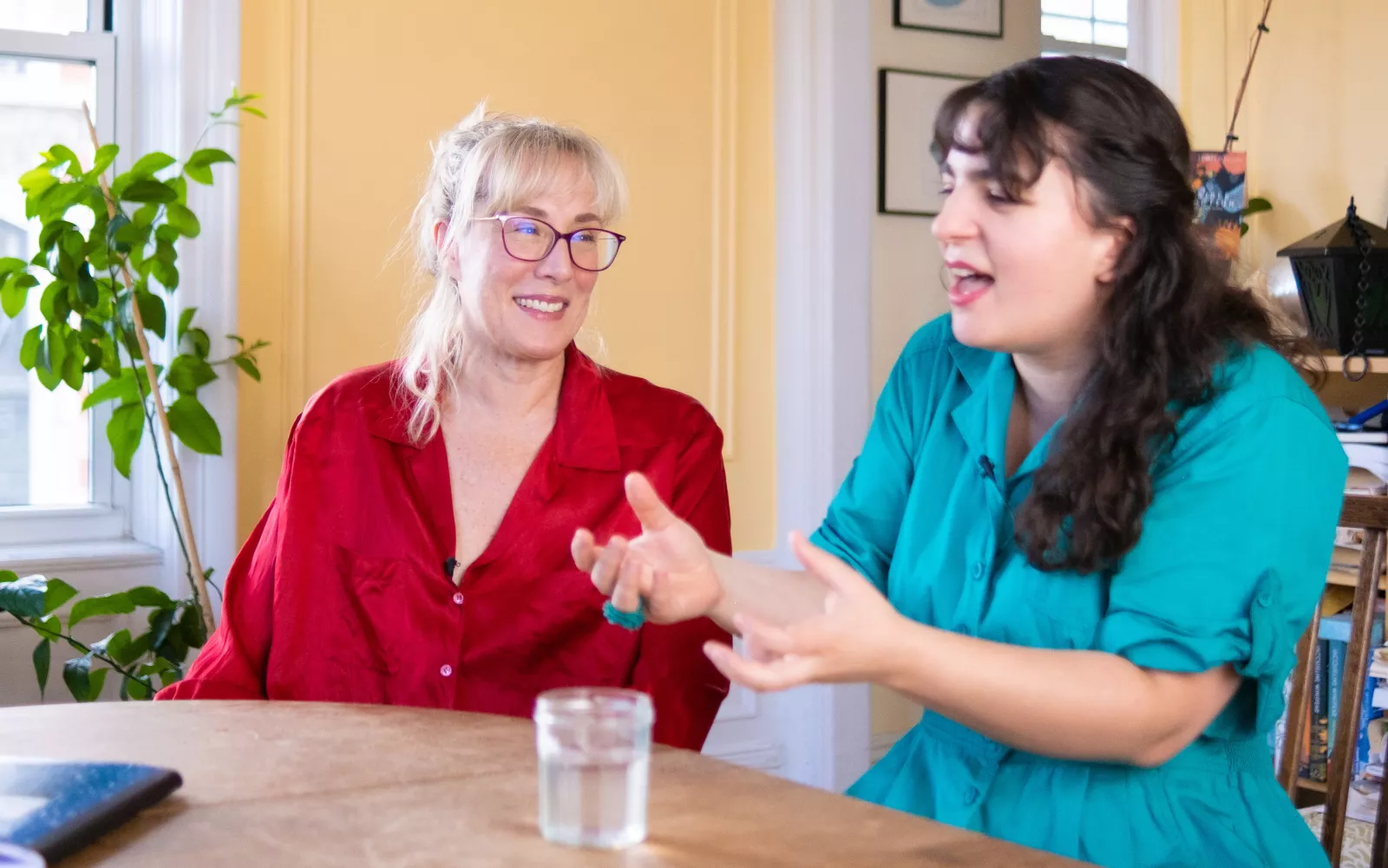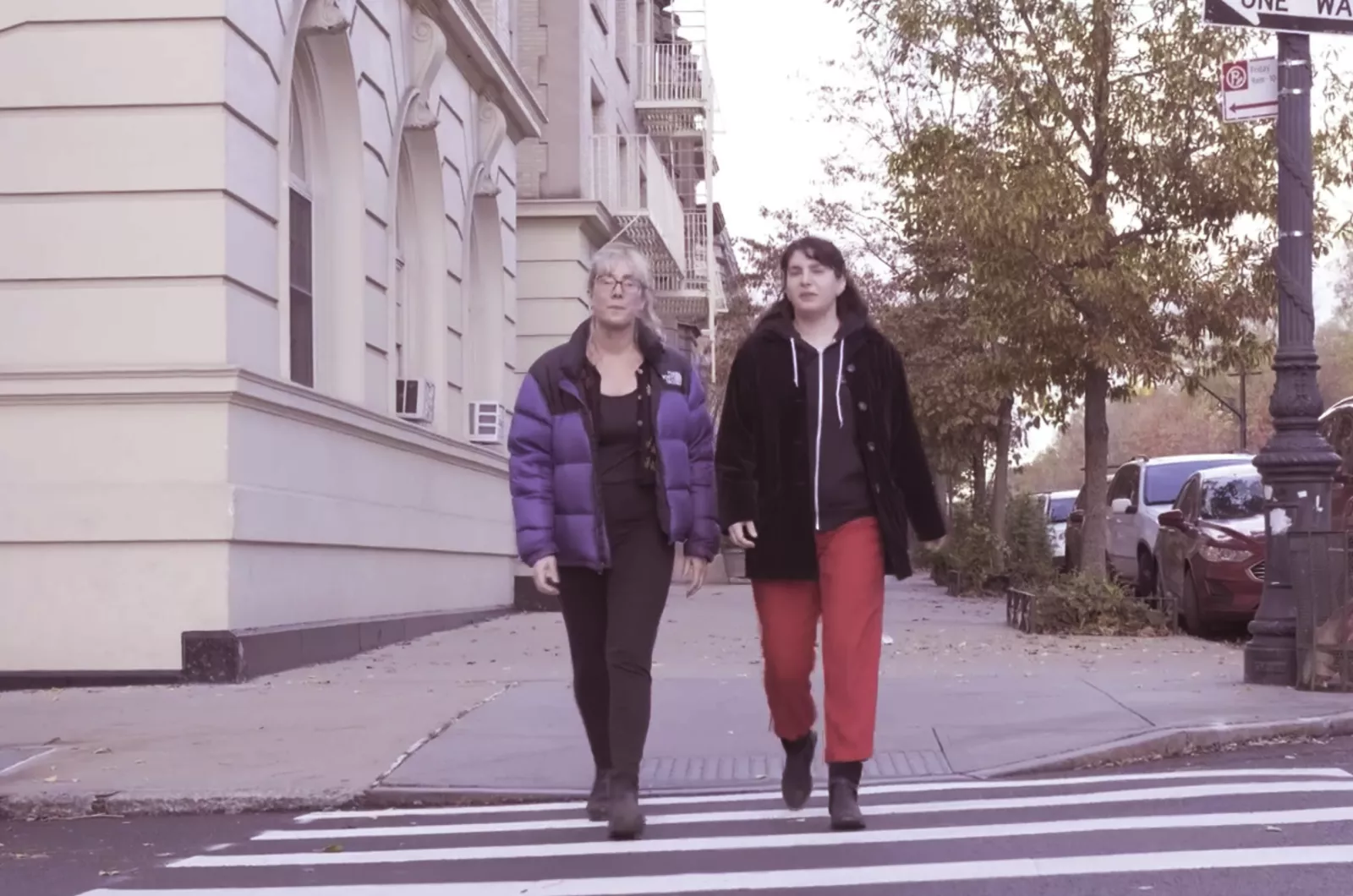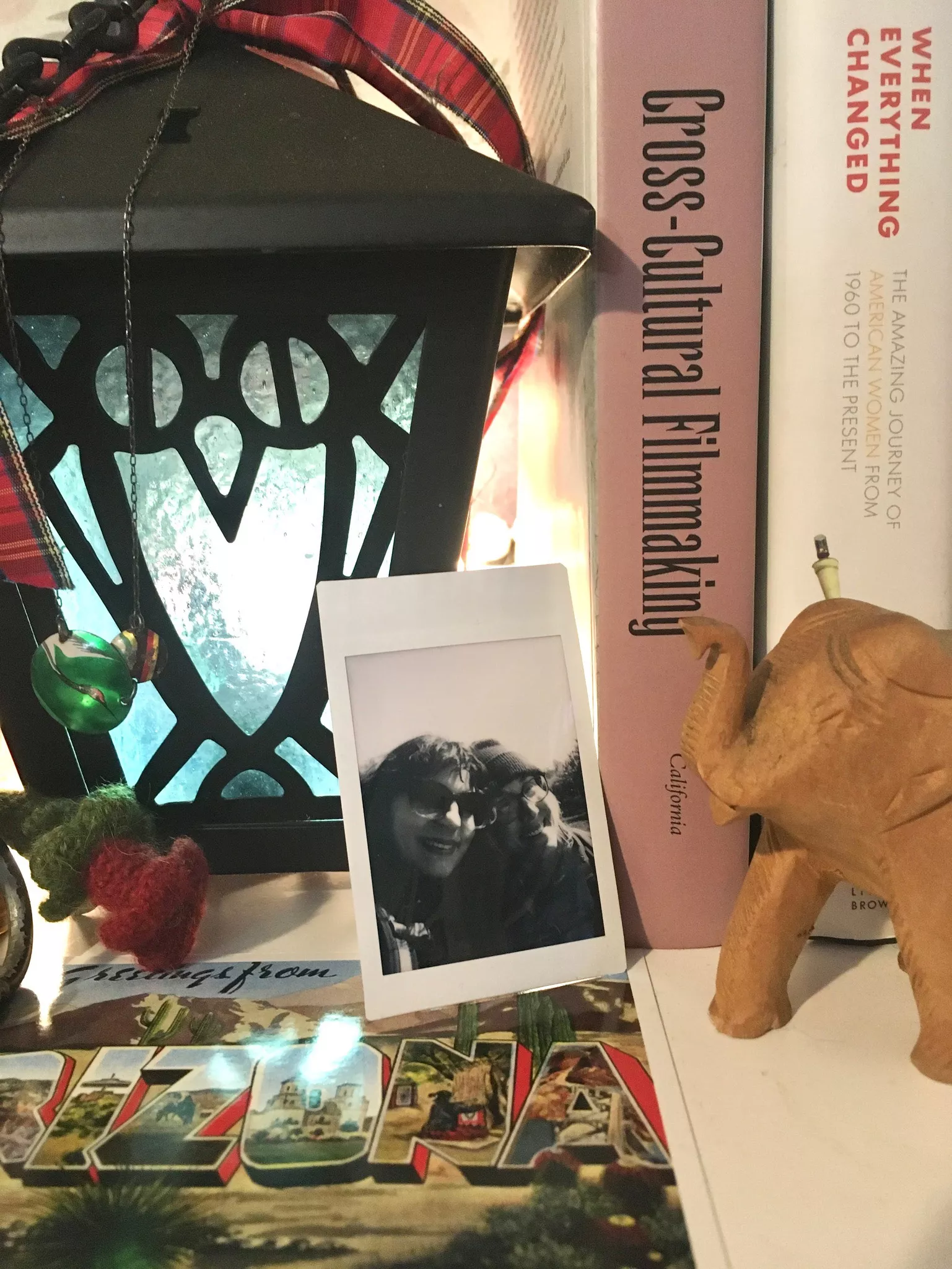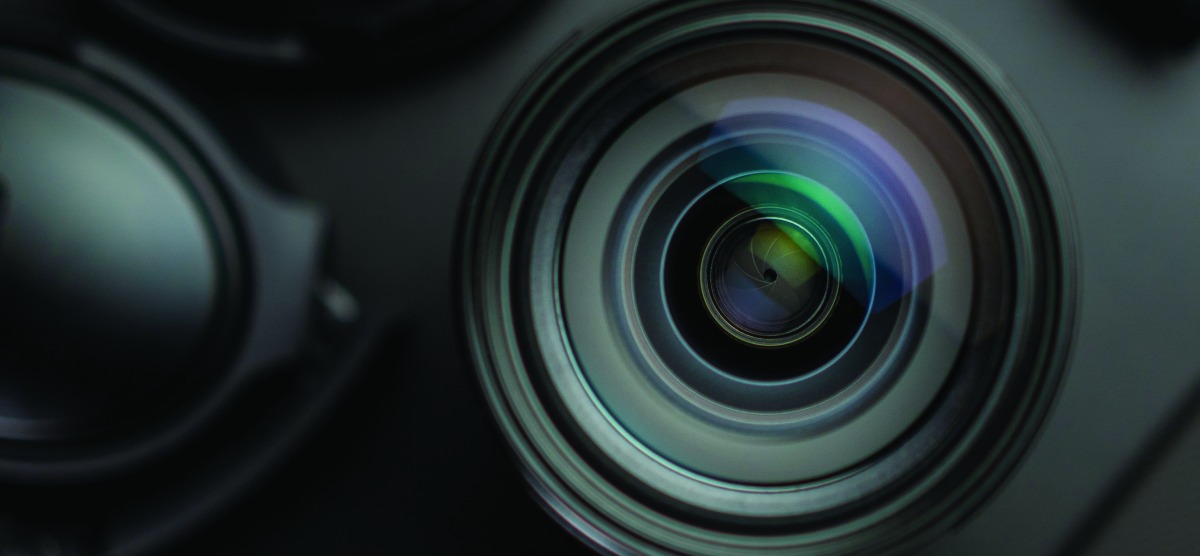
Production Notes
Brooklyn filmmakers Sarah Schenck ’87 and Margaret Sclafani ’08 take time out to talk about filmmaking and friendship.
Although Sarah Schenck ’87 and Margaret Sclafani ’08 graduated from Bryn Mawr two decades apart, a mutual love of film caused their paths to cross. The two filmmakers, who are both based in Brooklyn, have collaborated over the years on several projects, including Schenck’s most recent film, The Invisible Extinction, a feature-length documentary about our vanishing microbiome.
Schenck (below left), a self-taught filmmaker, has made both prize-winning shorts as well as feature films and has often focused her lens on public health issues. Sclafani (below right) worked her way up in the industry, turning her hand to many aspects of the craft, including cinematography. Her feature film Greetings from Arizona is currently in post-production.
With The Invisible Extinction set to open theatrically in New York City and Los Angeles in the new year, Schenck and Sclafani sat down at Schenck’s dining room table in her sunny fifth-floor Park Slope apartment to talk about filmmaking, friendship, and being a woman in a (yes, still) man’s world.
A Serendipitous Meeting
Margaret Sclafani: I became aware of Sarah when I was at Bryn Mawr applying for externships. I knew even though I was an anthropology major that I wanted to do film, and at the Careers Center there were these binders of people, and Sarah was one of just a few filmmakers.
Sarah Schenck: At the time, I was finishing my first feature film, which was called Slippery Slope. It’s a comedy about a young woman who is an artist and feminist who finds herself directing a porn film.
When Margaret came to work with me, I lived in a little apartment on Union Street in Brooklyn with my husband and two very small children. I think my parents might have been visiting. It was pandemonium and a highly challenging work atmosphere to get anything done, especially something as complex as finishing post-production on a feature film. One of the many remarkable things about Margaret is that she is completely unflappable.
MS: I’ve always found myself working out of people’s homes. It’s really a nice part of independent filmmaking. And it gave us a head start on the whole work from home ethos where, for better or worse, there’s a lot of things going on at once and it’s important to be able to focus, even in the midst of a chaotic atmosphere with 15 people doing different things.
"Watching a director with the camera and actors to me felt a little bit like falling in love."
— Sarah Schenck
Different Paths
SS: Film is a highly challenging field. It’s not something for the fainthearted, and I’ve been astonished at how Margaret has adapted and risen in this challenging profession. I don’t think I realized how hard it was going to be when I started off. Unlike Margaret, who had a vision early on that she wanted to be a filmmaker, I became one kind of by accident.
When I was at Bryn Mawr I studied art history, and I loved the world of beauty and ideas. I had an internship at the Metropolitan Museum of Art right after I graduated, but after working in the paintings conservation department and giving talks on 15th- and 16th-century Flemish painting for a summer, I realized I wanted to do something more politically related, and I ended up working in a nonprofit devoted to Latin American affairs.
I got my graduate degree in political economy and worked for the New York Times in Rio before coming back to New York City. When I was working for the New York City comptroller’s Office, one of my colleagues decided to make a film and he was a friend of mine so I helped him, In watching him do that, I realized I could actually do it too. Watching a director with the camera and actors to me felt a little bit like falling in love. At that point I started working on a short script of my own and made a number of short films. I love that format! I eventually moved on to making my first feature, but while I was employed for many years as the NYC comptroller’s senior advisor for education policy. I’ve always had other jobs to sustain my filmmaking habit.
MS: Bryn Mawr was where I discovered I was interested in being a filmmaker. I did a lot of acting with the Bi-Co community, and I was also a painter and a dancer. My friends encouraged me to take my first film course. I watched a lot of films. You could rent three films at a time from the library, and I would rent three and watch them all night long.
My first film course was Poets of Cinema, and that opened my eyes. I’d already seen and really liked Amelie, which came out when I was in high school, and seeing other foreign films cemented for me what cinema can be. There was this short that I did with a friend in senior year called Pamplemousse, and it was sort of a horror film about the making of grapefruit juice. It’s a lot of shots of the grapefruit getting smashed and cut up—massacred. I was the kid with the Handycam just filming a lot of what was going on in the world. Then working with Sarah, I saw that, OK, this is something that people can do for a living.
I graduated into the recession and applied to a bunch of different positions. I was hired as a researcher for a documentary film in the D.C. area and was quickly promoted to post-production coordinator. The documentary was about Molly Goldberg, a woman who worked in early television. It was a super inspiring story about women in the industry that I was interested in entering. Sarah and I kept in touch, and I came up to New York to work on a short film with her called Cleats.
SS: It was written and directed by my dear friend and brilliant filmmaker Maria Agui Carter. It was a Spanish-language production about a young man on scholarship at Harvard, desperate to play soccer but unable to afford new cleats, and what his parents had to do to provide him a pair. We all had fun painting my babysitter’s home and dressing the set.
MS: After that, I moved into post-production coordination on feature-length documentary films, and then I started getting into the camera department. I eventually made my way to New York in 2010.
SS: One of the things Margaret did that was really smart, when I look back on our different paths as filmmakers, is that she was versatile. She does a lot of shooting and she’s a cinematographer, but she’s also an editor. She’s also a producer and production coordinator. And because of that, she was able to earn money in the field as she was growing and developing as an artist and filmmaker in her own right. I really admired how she did that.
The Invisible Extinction
SS: The film that I’m just completing now, The Invisible Extinction, co-directed with Steven Lawrence, is a movie that I felt compelled to make. It’s my first feature documentary, and it came into being because one of my two daughters almost died from an anaphylactic reaction to a cookie. I was in the emergency room, and they said, "We have no idea why people get allergies; it’s a mystery," and so I started researching like people do when they have a serious health issue. Evidence continues to build that damaging our microbes—our internal ecosystem—can trigger food allergies and other chronic health issues.
What really galvanized me was the desire to help my kids with their health issues, then I thought: if I’m having these issues, a lot of other families probably are too—maybe what I’m learning can help other families avoid what we’ve gone through. That would be a good day’s work. And it continues to be a real driving force for me. I’m very excited to have people see the film and talk about it in ways that are useful to them. The research is evolving rapidly, and scientists around the world are doing groundbreaking work to make all our lives better.
The Invisible Extinction began as a work-for-hire piece on the microbiome for a PBS news program. The show went off the air, and I was left with this footage and an obsession with the microbiome. I couldn’t stop thinking about it. I sought out scientists at the top of the field of microbiome research here in New York City—Maria Gloria Dominguez Bello and Martin Blaser—both of whom have the rare ability to communicate in simple language. I wanted to shoot them, but I couldn’t get any funding together. It was only because Margaret had faith in the film and was my friend that we were able to record the initial interviews and, on the strength of the footage that she shot, move the project forward.
My filmmaking partner Steve's distinguished career in documentary filmmaking gave our funders the confidence that the project would have high production value and reach completion—not a guarantee by any means in this highly challenging arena. As a co-director, Steve's personal connection to the subject matter made him sensitive to the nuances of the representation of characters undergoing, at times, extreme physical and emotional duress. As our line producer, Steve called upon his deep contacts in the documentary film world to crew our film with exceptional shooters, sound recordists, and post-production talent, while also contributing brilliantly whenever necessary to the shooting, recording, and editing of our film.
MS: I came on to film a few other things when they had pickup shoots later on in the project, but I was mostly mostly involved as a videographer early on.
Motivation
SS: When I was making my first feature film, my dad asked me if I was doing something that was making the world a better place, and I kind of scoffed since I thought I was trying to make something that was provocative commentary and started a conversation. I have come around to thinking that it was actually a very good question, and I do aspire to make the world a better place through my work.
MS: I’m looking to make films that have an emotional impact and move people in different ways—to action, to laughter, to tears. Filmmaking is a way of sharing stories. You meet so many different people or you create characters from some kind of human truth. Working in documentary and narrative projects, I’m always trying to find that emotional impact and get that across to the viewer. As a film viewer and creator, the films that move me are more often narrative projects. A lot of times, women’s stories are especially attractive to me. I’ve often gravitated toward working with other women as collaborators and storytellers because those are the stories I want to bring out into the world a bit more and also because in my field I’m very much surrounded by men. Oh wow, a woman in the camera department! Over the years there have been more women behind the camera, but there are still vastly more men directors, cinematographers, and directors of photography, and it’s challenging.
"I’m looking to make films that have an emotional impact and move people in different ways—to action, to laughter, to tears. Filmmaking is a way of sharing stories."
— Margaret Sclafani
Greetings from Arizona
MS: I’m director of photography and co-director with my friend Zach Singer on Greetings from Arizona. We came to the project in 2020 working from home. We were both working for MTV News at the time and feeling the weight of the stories and the 24-hour news cycle. So, the two of us decided to drive across country in November 2020 just after the election was called. We wanted to explore the political landscape that we found ourselves in and also the physical landscape of the United States.
I decided to act as well as doing a lot of the technical side of things on the production side, and Zach, with his skills as an editor, is now taking the lead in post-production. We really wanted to capture that time in the pandemic on film, but it became a bigger story. He and I had a friend die the year before who we had worked with, and so our friendship formed in a real openness about grief that also became part of the discussion, especially as we were being faced with so much death in our country. We wanted to look at that from both a national and personal level in the storytelling.
I wore a lot of hats, but I had experience doing that as a freelancer where I was often the only person in the studio or on location setting up lighting, multiple cameras, and miking talent.
Lessons Learned
MS: What I’ve learned from Sarah is definitely perseverance. And also really appreciating everyone that’s on your team. I think Sarah’s always been great as a director and producer and a great caretaker of people. She always has chocolate at the ready! I think that’s so important when you’re leading a group of many different people, to really be aware of everyone at every stage of production. She’s a super welcoming and kind person.
SS: Margaret has a kindness about her and a gentleness that is not so typical in the hardscrabble world of independent filmmaking and there’s an integrity about her. She’s doing her thing the way she’s doing it and being true to herself while also getting the job done.
“Margaret has a kindness about her and a gentleness that is not so typical in the hardscrabble world of independent filmmaking.”
— Sarah Schenck
Bryn Mawr Women
SS: One of the cardinal traits of being a Bryn Mawr woman is that we love diversity in every way that you could imagine it and express it. I was friends with so many international students at Bryn Mawr, which I really loved, and that has informed my work. I’m still in touch with many of these friends, and it makes the world feel like a very small place when you know people in Budapest and Beijing. That’s been a blessing for sure, and it has informed my storytelling. I am profoundly grateful for the excellent education I received inside and outside the classroom at Bryn Mawr.
MS: I think Bryn Mawr attracts a certain kind of person who is already intellectually curious, and it fosters that interest in asking questions and figuring things out. As a filmmaker, whether it’s a narrative film or a documentary project, a lot of what we do is we ask questions and try to figure things out.
“Sarah’s always been great as a director and producer and a great caretaker of people. She always has chocolate at the ready!”
— Margaret Sclafani
The Invisible Extinction opens in theaters on January 6. It is also streaming (for rental) on all major services (iTunes, Google Play, Amazon and Vimeo on Demand) in the U.S., U.K., and Australia. Learn more about the film at theinvisibleextinction.com. Learn more about Greetings from Arizona at greetingsfromarizonafilm.com.
Published on: 02/19/2023
